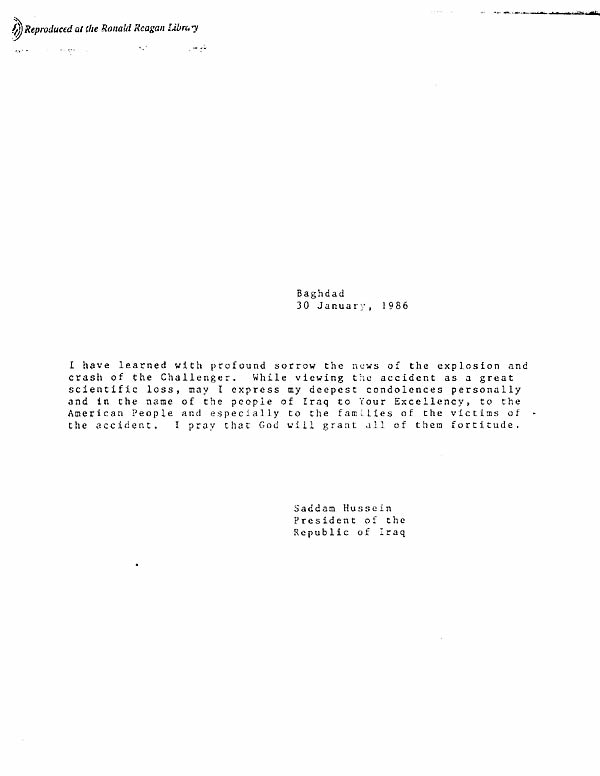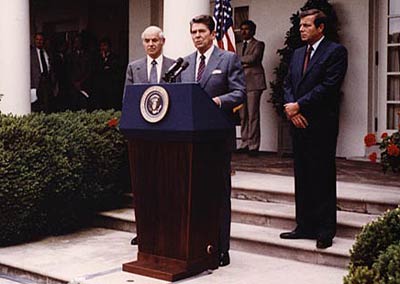Digging through the archives: space policy in the Reagan White Houseby Dwayne A. Day
|
| Occasionally a researcher will stumble across a real surprise. It may not be an earth-shattering historical discovery, but it will knock him back mentally for a moment or two. |
For the scholar, however, there is a payoff—or at least there should be; sometimes you spend hours or even days going through a collection and find nothing of value. The reward is, of course, finding documents relevant to your research; sometimes, very rarely, documents that can fundamentally change the historical consensus of an event. But in virtually all of these cases context is everything. It is the researcher who supplies the context for the document. Two researchers sitting next to each other can both find significant documents, but neither would understand the other’s discovery—and neither would care. They are looking for different things and have different definitions of what is valuable.
Of course the discovery is insufficient by itself; it is up to the researcher to explain that discovery to a wider audience, placing it in a narrative, and of course, publishing it.
Have I lost you yet? Stick with me. There’s a payoff.
Occasionally a researcher will stumble across a real surprise. It may not be an earth-shattering historical discovery, but it will knock him back mentally for a moment or two. Usually this is a piece of paper. Rarely it is something else. For instance, several years ago I was working as a consultant for a magazine doing a story on the Black Duck, a legendary Prohibition-era rumrunning boat that had been shot up by the Coast Guard off the coast of Rhode Island in 1929. Three people were killed by the feds and there were claims that the deaths were not justified, that the Coast Guardsmen had been trigger-happy. The magazine wanted to know what was in the investigation file, particularly photographs of the boat. So I headed down to the National Archives and did some digging and after several dead ends I found the right file. In the bottom of the dusty old box was a small faded envelope. I opened that up and dumped its contents out onto the table—three .45 caliber Tommygun bullets that had been dug out of the Black Duck’s wooden hull. The magazine editor was thrilled and sent a photographer down to the archives to take photos of the bullets.
A colleague had a more grisly find. He was doing research on an Air Force lawyer who had investigated the shootdown of an American aircraft by the Soviet Union in the 1950s. The entire crew had died, but only two bodies had been recovered. He was looking through the lawyer’s files when he came across an envelope and opened it up. Inside was a discolored clothlike object that he suddenly realized was a piece of human skin from the wreckage. Somehow it had ended up in the investigative file, stored away for decades in the National Archives. He notified an archivist, who then had to treat the file as a biohazard.
So what does this discourse on the tedium of archival research have to do with space?
A few weeks ago I went to the Ronald Reagan Library in Simi Valley California to look at their collection of space documents. This was only a quick visit, not a complete review of their files, and I did not have high hopes despite the richness of Reagan’s space legacy, which included major policy decisions such as the Strategic Defense Initiative, the National Aerospace Plane, the space station, and the Challenger accident.
My low expectations were due to the fact that Reagan’s presidency was only twenty years ago, and it takes presidential libraries decades to index materials and many more years to declassify them. My own opinion is that much of the delay is not because of national security issues, but staffing. Presidential libraries are privately run and do not provide sufficient staff to index their collections, preferring to spend the money on hagiographic museums. The Reagan Library confirmed this suspicion. I was told that large sections of the collection have not been indexed and are therefore inaccessible, even though the library has held them for seventeen years now. I was also told that if I requested the declassification of a document, it would take the library seven years simply to copy the document and submit it to a government agency for declassification review, where it would probably take another three to seven years to be declassified. At that rate, it might be 2016 before I could ever see a document from 1982. The library has a goal of reducing that waiting time from seven years to three years, but considering that Reagan praised the private sector, it seems bizarre that the National Archives—a federal bureaucracy—is far more efficient at this task than the privately-run Reagan library.
Although I was not planning on spending a lot of time going through the collection, I was hoping to find a few things. In particular I was looking for any briefings to Reagan or his senior staff about progress in the Soviet missile defense program. In recent years it has become apparent that the Soviet Union had a missile defense program at least as ambitious as Reagan’s Strategic Defense Initiative. Reagan was widely criticized for refusing to abandon SDI after the 1986 Reykjavik summit—critics of SDI thought he was foolish for not giving up what they viewed as the unworkable SDI in favor of an arms reduction treaty. I wanted to see if he had information on just how ambitious the Soviet SDI program was at the same time. I was also interested in anything on military use of the Space Shuttle and the decision to remove military payloads from shuttle flights after the Challenger accident.
| As you go through a collection of documents, eventually you can hear the voices of the people talking about the events of the day. But the Reagan Library’s Outer Space collection often sounded, well, a little out there… |
Alas, I had no luck. There are two boxes of documents concerning SDI, but these primarily consist of letters from members of Congress to the administration either supporting or opposing the program. The most relevant civil and military space documents would have been in the National Security Council files. Of the three staffers who worked on space issues at the NSC, none of their records are accessible because they have not yet been indexed, which requires removing classified documents and making the unclassified material available to researchers. The papers for one of those staffers, Gil Rye, are so sensitive that even the names of the folders in that collection have to be reviewed for declassification.
What the library does have is sixteen boxes in their “Outer Space” general file, and this description is not simply appropriate, but occasionally deeply ironic.
The boxes primarily contain correspondence sent to the White House. Some of this involves documents and memos from NASA and the Office of Management and Budget concerning weighty issues such as the Challenger accident investigation and space station cost overruns. Anybody interested in tracing the history of how the space station grew from Reagan’s initial $8 billion price tag to what it is today (probably over $50 billion by now, depending upon what you include—but not yet the $100-billion price tag frequently applied by critics and lazy reporters), would find this material useful.
As you go through a collection of documents, eventually you can hear the voices of the people talking about the events of the day. You can read the letters and the responses and get a sense of what happened all those years ago. But the Reagan Library’s Outer Space collection often sounded, well, a little out there…
In addition to the serious material there are lots of letters from the general public. A substantial portion of this public correspondence is from nutcases, or at least people with strong opinions about fringe subjects. There was a report from an anti-vivisection group about the monkeys that were going to be flown on an upcoming Space Shuttle mission. There were letters from people who wanted to lobby President Reagan to support their crazy ideas. One amusing letter was from a man who claimed to have discovered a revolutionary propulsion system ten times as efficient as the Space Shuttle’s rocket engines. He requested a private meeting with Reagan in San Jose to demonstrate why he deserved a government contract to build it.
And then there were the Challenger materials.
They were spread throughout several boxes that I perused. There were briefings on the Shuttle’s future launch manifest, then on hold because of the accident. There were reports about the status of the investigation. And there were reports about the discovery of the crew cabin and the remains of the crewmembers. Most were short, terse, unemotional. But then I opened one folder that was filled with telegram letters of condolence from heads of state. At the top of the pile was a paper that is reproduced below.
It’s from Saddam Hussein.
The folder was filled with such telegrams, generated by protocol officers in countless embassies around the world. They don’t really mean anything. The heads of state in those countries never even know that they are being written.
| The document means nothing. But it’s still weird. |
At the time, the United States leadership knew that Hussein was a monster who had slaughtered his own people. But they were willing to overlook that fact, and to provide covert assistance to him in order to counterbalance Iran. (I did not check to see if there was a letter of condolence from Iran as well.) White House officials hoped that the Iraqis and the Iranians would continue to fight each other, as long as their conflict did not spill out into the Persian Gulf. It did, on several occasions.
The document means nothing. But it’s still weird. Nearly twenty-one years later Hussein sits in an American prison, awaiting execution.
I pondered that fact for a couple of seconds, and then went on to the next box.
 |
